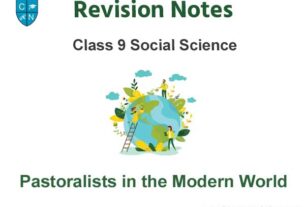Please refer to Population Class 9 Notes and Questions with solutions below. These revision notes and important examination questions have been prepared based on the latest Social Science books for Class 9. You can go through the questions and solutions below which will help you to get better marks in your examinations.
Population Class 9 Notes and Questions
Population
- People are themselves resources with varying qualities.
- Population is the point of reference from which all other elements are observed and from which they derive significance and meaning like resources, calamities, disasters etc.
- The Census of India provides us with information regarding the population of our country.
- Census is an official enumeration of population done periodically. In India census is held every 10th year.
Population Size and Distribution
- Uttar Pradesh accounts for about 16 per cent of the country’s population.
- India’s population as in March 2001 stood at 1,028 million accounting for 16.7 per cent of the world’s population.
- Almost half of the India’s population lives in just five states. These are Uttar Pradesh, Maharashtra, Bihar, West Bengal and Andhra Pradesh.
- Population density is calculated as the number of persons per unit area.
- Population density is affected by relief of the area.
Population Growth and Processes of Population Change
- The numbers, distribution and composition of the population are constantly changing. Hence population is a dynamic phenomenon.
- Growth of population refers to the change in the number of inhabitants of a country/territory during a specific period of time.
- Since 1982 India’s population growth rate is on the decline.
- When more than a billion people increase even at lower rate, the total numbers added becomes very large.
- The declining trend of the growth rate is indeed a positive indicator of the efforts of birth control.
- The natural increase of population is the difference between birth rates and death rates.
- The number of death per thousand persons in a year is the Death Rate.
- Migration is the movement of people across regions and territories.
- Migration can be internal and international.
- Migration changes not only population size but also the population composition of urban and rural populations in terms of age and sex composition.
- Pull and push are the factors responsible for migration.
- The age composition of a population refers to the number of people in different age groups in a country.
- The population of a nation is generally grouped into three broad categories, namely children (generally below 15 years), working age (15 – 59) years) and aged (above 59 years).
- Sex ratio is defined as the number of females per thousand males in the population.
- The sex ratio in India has always remained unfavourable to females.
- Keral has the highest sex ratio whereas Delhi and Haryana are amongst lowest.
- A person of seven years of age or above who is able to read and write with a certain understanding is called a literate.
- Males have more literacy than females.
- The distribution of the population according to different types of occupation is referred to as the occupational structure.
- Primary activities include agriculture, animal husbandry, forestry, fishing, mining and quarrying etc. Secondary activities include manufacturing industry, building and construction work etc. Tertiary activities include transport, communications, commerce, administration and other services.
- Sustained efforts of government programmes have registered significant improvements in the health conditions of the Indian population. Death rate is considerably reduced.
- It is a matter of concern that the per capita calorie consumption is much below the recommended level in India.
- Adolescent population constitutes one fifth of the total population of India.
- Adolescents in India face the problem of malnutrition that can be dealt with by spreading awareness, literacy and education among them.
- The Family Welfare Programme has sought to promote responsible and planned parenthood on a voluntary basis.
- National Population Policy 2000 aims at improving conditions of adolescents, aiming at encourages delayed marriages and child bearing, educating about risks of unprotected sex and provisions for nutritional needs.

We hope the above Population Class 9 Notes and Questions are useful for you. If you have any questions then post them in the comments section below. Our teachers will provide you an answer. Also refer to MCQ Questions for Class 9 Social Science

